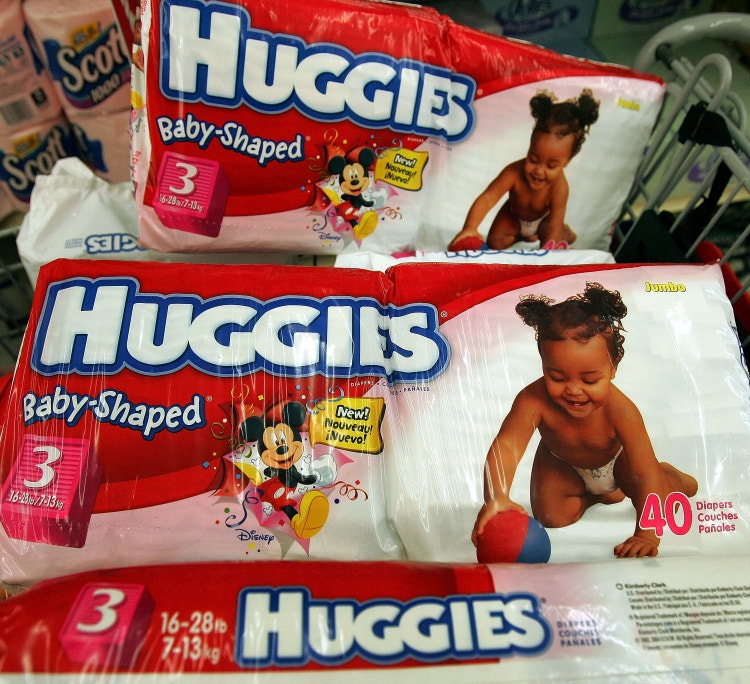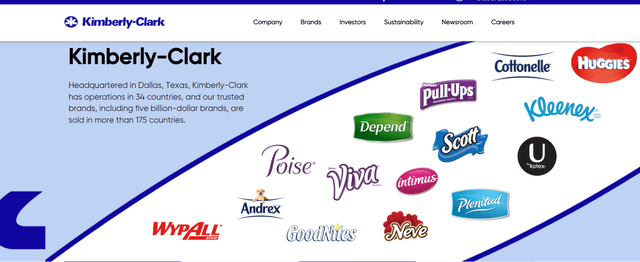Kimberly-Clark: Half A Century Of Dividend Growth

Summary
- Investors interested in dividends like to see companies increase their dividend payout on a regular basis.
- Kimberly-Clark is a dividend payer that's increased its dividend for 50 straight years.
- Kimberly-Clark is a consumer goods giant.
- Dividend growth has slowed in recent years, but the yield is above average.
Tim Boyle
I'm an investor that's interested in income. Outside of retirement fund investments and an investment in a covered-call ETF, I do not own any shares that do not pay a regular dividend or distribution (the covered-call fund pays, but some companies within the fund do not).
Dividends are straight cash, and I can do anything I want with the payments. If I need some of the income to pay bills, I can do that. If I want to take a vacation with dividends, I could save them for a while and take a trip somewhere nice. However, this is not my goal at this time. Reinvesting as many of the dividends as possible is my goal as an income-focused investor who is still working. This way, the dividends I earn can buy more shares that will earn dividends.
My dividends can earn dividends and build a veritable snowball going forward. Even if I can find no additional capital to deploy in the market, as long as I leave my investments alone, the dividend income should grow. This results from two separate concepts. First, a growth in my annual dividend income can come from companies deciding to increase their dividends periodically. Secondly, I can reinvest the dividends to buy more shares of the stocks I own or invest in new funds or companies. Both of these levers contribute to growing my dividend income over time.
To earn dividend income, I own some dividend-paying stocks as individual holdings. I like to purchase shares from companies that have a history of increasing the dividend. One of the companies that I currently own is Kimberly-Clark (NYSE:KMB).
Kimberly-Clark brands (Kimberly-Clark investor relations page)
Why I Own Kimberly-Clark
I chose to purchase a few shares of Kimberly-Clark for a couple of reasons. The first is the fact that it's a company I understand. It sells consumer goods. These staples are sold in more than 175 countries around the world, even though the company is based in Dallas.
The company sells five billion-dollar brands in terms of annual sales, along with other less lucrative brands. These include popular (and necessary) hygiene products like toilet paper and disposable diapers. As long as people have babies, there will be a market for Huggies. People in developed countries are not likely to decide going back to a time without toilet paper is a good idea. Remember the panic in 2020 when the shelves usually filled with toilet paper were empty? Many viewed this a crisis of epic proportions. There is a strong market for the products KMB sells.
Companies like Kimberly-Clark are great to own in a recession. Demand for new cars can go down when people are out of work, as can the demand for more expensive consumer items like computers and TVs. However, few people are going to cut back on necessary items they use every day like toilet paper or toothpaste or soft drinks. Some of the products KMB sells fall into these categories. Additionally, customers that are pleased with their purchase will be more likely to make additional purchases. Consumers have to buy staples frequently, and KMB offers important staples people need, along with well-known brands associated with those products.
The second reason I chose to buy a few Kimberly-Clark shares is tied to the company's dividend. KMB has increased its dividend for 50 consecutive years. That is a record matched by few companies available on the US market. Not only does this dividend have a long history of growth, it's also relatively high in terms of its yield. The current yield is 3.71%, which is well above the yield that you'll get from purchasing an S&P 500 fund (SPY) or a total market fund like the one offered by Vanguard (VTI). Vanguard's Total Stock Market fund currently yields 1.67%. Therefore, the latter will take a long time to grow to a substantial payout.
The growth of the KMB dividend has slowed down in recent years. The most recent increase was $0.02 per share per quarter, which works out to a 1.72% increase. The last five years have averaged a 3.57% annual increase in the dividend.
Will The Dividend Grow Rapidly Going Forward?
The relatively high yield, along with the relatively slow growth rate, brings up the question of whether KMB will be able to increase the speed of the dividend growth in the near term.
Companies with a low dividend payout can increase their payments for a while as long as their revenues and income levels stay stable. Once the payout level gets too high, however, the dividend growth will have to slow down or stall. This is where KMB is today.
The company's revenues are relatively impressive at more than $20 billion per year, but they haven't really grown over the past decade. In 2013, the company brought in $19.561 billion in revenue. By the end of 2022, that number had only grown to $20.175 billion. All of the years in the interim saw annual revenue come in between $18.4 billion and the 2022 number.
KMB should have pricing power as a brand that people use. Therefore, inflation could lead to higher prices and higher revenue in the short run. However, the company has to also buy raw materials, to which it will then add value and turn into finished products, but the raw materials will also likely see an increase in price, along with increased labor costs. This means that higher revenue will not necessarily result in higher profitability.
Kimberly-Clark has also stalled out in terms of its net income. This can vary widely from year to year because of capital expenditures, tax changes, and whole host of other extraordinary events. Therefore, a company might have an outlier year with lower earnings here and there. KMB's net income has grown only from $5.53 per share to $5.72 per share over the past ten years, despite a share buyback program. There are now about 12% fewer shares on the market than there were a decade ago, and this should reflect positively toward the EPS number. Yet, there has been little growth in the EPS.
This has led the dividend payout ratio to exceed 80% in some recent years, including 2022. This high payout ratio means that the company will have trouble increasing the dividend payment in future years unless it can improve its profitability.
One positive that's evident on the balance sheet is the debt level. At a time in which many companies have greatly increased leverage to buy back shares, KMB has only increased its long-term debt by a little more than $2 billion to around $7.8 billion as of the 2022 annual report. When compared to some companies like AT&T (T) that have taken on massive amounts of debt in recent years, this does not reflect as negatively as it might.
Conclusion
I'm happy to hold KMB shares because of the relatively high dividend and its status as a mature consumer-staple company. However, I don't think I will be adding any shares in the near future. The current forward P/E ratio of 21.42 is not ridiculously high when compared to some other consumer goods companies. For example, PepsiCo (PEP) and Procter & Gamble (PG) have P/E ratios in the 24 range. However, the revenue and income have stalled in recent years, despite the company having a wide range of popular products and a global market. Perhaps, if the dollar weakens, foreign sales numbers might improve. However, low revenue growth and a high dividend payout make a rapidly growing dividend unlikely in the near term, and it will also likely keep the share price from growing much, as well. Therefore, I would rate KMB stock as a hold at present.
This article was written by
Disclosure: I/we have a beneficial long position in the shares of KMB either through stock ownership, options, or other derivatives. I wrote this article myself, and it expresses my own opinions. I am not receiving compensation for it (other than from Seeking Alpha). I have no business relationship with any company whose stock is mentioned in this article.
Additional disclosure: I am not an investment professional. The preceding is intended for informational and educational purposes. Please make sure to perform due diligence before investing in equities, as losses up to all capital invested can occur.
